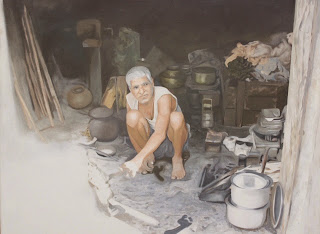Attihannu Mattu Kanaja (Fig Fruit and the Wasps) by Bangalore based artist MS Prakash Babu paints an abstract landscape
A series of abstract landscapes meld into one another, interrupted by rural topography, undulating fields and framed protagonists - the cinematic experience captivates you with its intensity. Fig Fruit and the Wasps, a full-fledged feature film in Kannada (with English subtitles) belongs to a different genre of cinema. Far from the cacophony and the song and dance routine that we have become used to, the film is a surprising rendition in restraint and silence.
The lone entry from India, Attihannu Mattu Kanaja was much applauded at the recently concluded Beijing International Film Festival. It was also awarded with the NETPAC Jury special mention at the 7th Bengaluru International Film Festival 2014 in the Asian Competition section. Directed and written by Bangalore based artist MS Prakash Babu, who completed his post-graduation in painting from Viswa Bharati University, Santiniketan. He explains, “Without adhering to any sloganeering, shouts, preaching and negating the readymade modes of storytelling, the film's narrative flows like a calm river maintaining its own natural rhythm. I am only facilitating that.”
It reminded me, albeit faintly of the minimalist and intense films of the early eighties, when Mahesh Bhatt was still making ‘art films’ and gave us gems like Arth and Saaransh. Although, one must point out that these films were high on narrative (as in storytelling), while the Fig Fruit is an abstract tale.
The film attempts to present a slice of life, there are no histrionics or undue emotion. The narrative lies in the visuals and the silence; lengthy pauses like photographic stills, with no twist in the plot waiting to unfold. Prakash Babu reaffirms, he has kept it deliberately minimal. His background in painting and sculpture is highly evident on his cinematic canvas.
He writes in his production note, “Topographically each space has its own rhythm. It is enmeshed with the culture, language and day-to-day life of the people living there. The space too has a kind of music. Both internal and external forces govern the patterns of that rhythm. Like a beautiful tree infested with the termite from within, the rhythm of this peaceful fertile land has been rendered hollow. It is not visible to the naked eye. Shallow from within, it still looks beautiful and charming from outside.” And, this is a space that the director and storyteller treads and explores.
The film follows Gouri, played by Bhavani Prakash (Prakash Babu’s wife), a documentary filmmaker who is trying to collect material for her documentary project on instrumental music. Along with a male friend, she visits a village to meet an instrumental musician, who has gone somewhere else to give a performance. Both of them are forced to stay in the village till the musician returns. Bhavani Prakash, a theatre artiste gives an admirable performance sans ‘theatrics’ as instructed by the director.
The 90 minute film is a series of images, which depicts their predicament as they wait endlessly for the musician to arrive. The never-ending road , the moving headlights of the car, the group of villagers standing like a sculptural installation, long silences, verses from the local poet, Vittal’s fascination with the poet - they all create a vocabulary that is both artistic and poignant. The pace in the first half an hour of the film makes you a little restless, but then it settles down into an easy rhythm.
There are two ‘dramatic’ scenes where a dead body is discovered and when Vittal strips and lies down next to Gauri. Despite the palpable tension the director intentionally chooses to not explore it further. In a couple of scenes where policemen enter the frame, the director again deliberately leaves it open for interpretation. As he says, “Sometimes “vision” isn’t what is visible, sound isn’t exactly what is heard.”
Devoid of a background score, the sound of the moving car, crickets buzzing at night and the thundering rain dominate the stillness. A silent sojourn that is sure to absorb you.
You can watch the trailer here http://youtu.be/1L05PFejrkg






